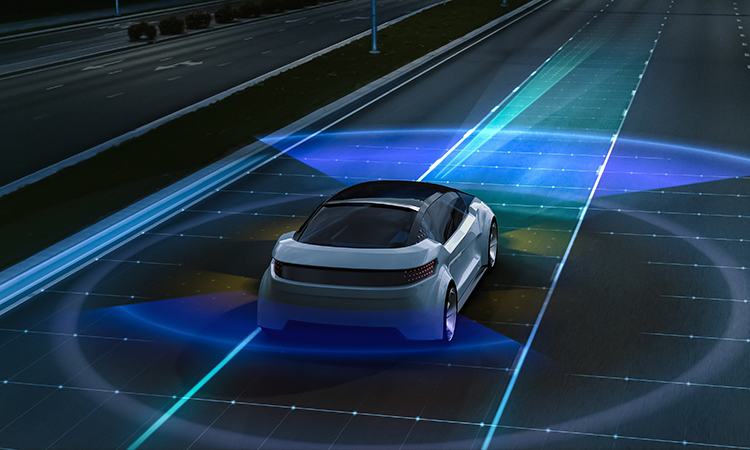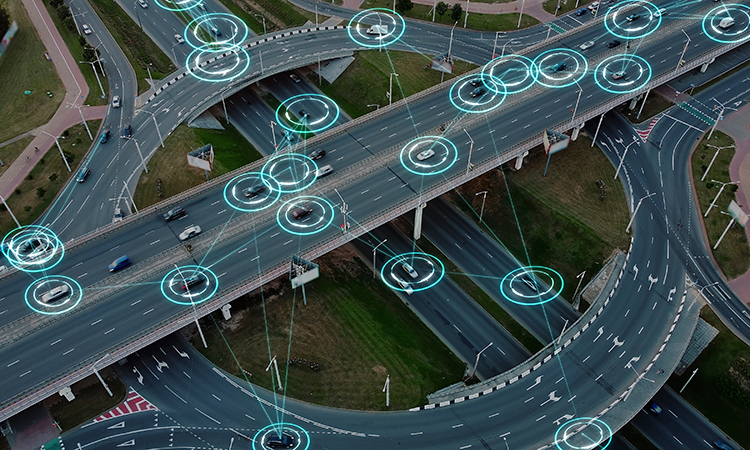The tech-driven roads of tomorrow: Advancing safety, efficiency and sustainability in the road ecosystem
- Like
- Digg
- Del
- Tumblr
- VKontakte
- Buffer
- Love This
- Odnoklassniki
- Meneame
- Blogger
- Amazon
- Yahoo Mail
- Gmail
- AOL
- Newsvine
- HackerNews
- Evernote
- MySpace
- Mail.ru
- Viadeo
- Line
- Comments
- Yummly
- SMS
- Viber
- Telegram
- Subscribe
- Skype
- Facebook Messenger
- Kakao
- LiveJournal
- Yammer
- Edgar
- Fintel
- Mix
- Instapaper
- Copy Link
Posted: 1 August 2023 | Gonzalo Alcaraz - International Road Federation | 1 comment
“The impact of AV technology on road safety is truly exciting, bringing both remarkable advancements and important challenges to address,” says Gonzalo Alcaraz, Deputy Director General of the International Road Federation, as he shares his thoughts on how new technologies are impacting the road ecosystem, with a particular focus on autonomous vehicles.


What technological trends are currently shaping the road ecosystem, and how do they contribute to making roads more efficient and sustainable?
Several technological trends are shaping the road ecosystem and revolutionising the way that we utilise roads in a more safe, efficient and sustainable way. First, the rising adoption of electric vehicles (EVs) is reducing greenhouse gas (GHG) emissions and our reliance on fossil fuels, leading to a greener future. The road ecosystem will have to deal with this issue by providing reliable charging network infrastructure.
The rising adoption of electric vehicles is reducing greenhouse gas emissions and our reliance on fossil fuels… The road ecosystem will have to deal with this issue by providing reliable charging network infrastructure”
Another game-changer is the development of connected and autonomous vehicles (CAVs), which have the potential to reduce road accidents caused by human error. CAVs can act at the same time as ‘sensors’ monitoring real-time traffic conditions, leading to optimised traffic flow, less congestion and more efficient road usage.
Smart traffic management systems are stepping up, as well. By using data analytics and artificial intelligence (AI), they predict traffic patterns and optimise traffic signal timings, which means less waiting time, reduced fuel consumption and lower emissions. Additionally, using renewable energy sources – like solar panels on roads – promotes sustainability by producing clean energy for EV charging and public lighting.
How do you see technology influencing the future of road infrastructure, and what benefits can be expected from these developments?
One of the main benefits I see that technology will bring to the future of road infrastructure is that it allows us to better understand what’s happening on the road in real-time, enabling us to manage situations more effectively by anticipating and acting faster. For example, with real-time data at our disposal, we can make informed decisions to reduce congestion and improve overall traffic management. As a result, commuters will experience reduced travel times, increased safety and a smoother driving experience.
[Current technology] allows us to better understand what’s happening on the road in real-time, enabling us to manage situations more effectively by anticipating and acting faster”
The integration of CAVs is another vital aspect of technology’s influence on roads. CAVs can communicate with each other and with road infrastructure, enabling seamless co-ordination and traffic optimisation. This integration ensures that roads are utilised more efficiently, leading to a higher road capacity and fewer accidents. It is worth also mentioning that existing road infrastructure is designed considering the human error (e.g. following the safe system approach), thus with the introduction of CAVs, our roads can look quite different (e.g. the width of the roads may be reduced), and we can work on re-designing and optimising urban spaces for better mobility systems.
Data-driven insights will also guide the construction and maintenance of roads. Authorities can decide where to spend money on maintenance and infrastructure upgrades by analysing data on traffic levels and usage patterns, as well as wear and tear. The environmental effect of road projects can be reduced by using sustainable materials and construction methods to increase road longevity.


CAVs can communicate with each other and with road infrastructure, enabling seamless co-ordination and traffic optimisation.
Can you provide examples of how technology has been implemented in cities to improve road infrastructure, and what have been the results?
Cities throughout the world have adopted technology to improve their road systems. One of the most popular is smart traffic management systems, which make use of sensors and AI algorithms to optimise traffic flow and minimise congestion, leading to more comfortable travel and lower carbon emissions. Another is connected vehicle technology, which enables cars to talk with one another and with roadside infrastructure, providing real-time alerts and warnings to improve road safety and prevent accidents.
Nowadays, cities can analyse numerous data sources to schedule preventative road repairs and boost road longevity, saving money and resources, thanks to data-driven initiatives like predictive maintenance”
Many cities worldwide have also implemented smart parking solutions that use sensors to guide drivers to available parking spaces, reducing traffic congestion, optimising parking space usage and improving overall efficiency. Numerous locations have also implemented renewable energy integration, which promotes sustainability and lowers energy costs. An example of this is the integration of solar panels onto highways.
Nowadays, cities can analyse numerous data sources to schedule preventative road repairs and boost road longevity, saving money and resources, thanks to data-driven initiatives like predictive maintenance. Smart crosswalks equipped with sensors and signals are also enhancing pedestrian safety and contributing to the efficient flow of both pedestrian and vehicular traffic.
How does the introduction of autonomous vehicle technology impact road safety, and what are some measures that can be taken to ensure their safe integration into the wider transportation ecosystem?
The impact of AV technology on road safety is truly exciting, bringing both remarkable advancements and important challenges to address. With the help of their cutting-edge sensors and AI, it can efficiently monitor and respond to their surroundings, helping to reduce crashes brought on by human error or fatigue, which are key contributors to accidents.
For global safety standards to be uniform, co-operation between governments, companies and researchers is essential”
Clear regulations and communication between autonomous and conventional vehicles; rigorous testing and validation; strong cyber-security measures to protect AVs from potential cyber threats; intuitive human-machine interface (HMI) design to keep passengers informed and engaged; data privacy regulations; and public awareness and education to promote responsible use are just a few of the steps that must be taken to ensure their safe integration into the transportation ecosystem.
For global safety standards to be uniform, co-operation between governments, companies and researchers is essential. For instance, together with important strategic partners in the road infrastructure industry, the International Road Federation (IRF) has established a dedicated Committee on Connected and Autonomous Mobility. Its main objective is to work on defining the role, vision and challenges of the road infrastructure sector in this transition period towards Cooperative, Connected and Automated Mobility (CCAM).


With the help of their cutting-edge sensors and AI, AVs can efficiently monitor and respond to their surroundings, helping to reduce crashes brought on by human error or fatigue, which are key contributors to accidents.
What role do you see government and policymakers playing in the development and implementation of technology in road infrastructure?
Their participation is crucial for establishing supporting regulatory frameworks, encouraging innovation and guaranteeing technology benefits society.
Government involvement with the public helps to address public worries about emerging technologies while also addressing the ethical and social ramifications of these developments, such as job loss due to automation and privacy concerns”
First, they create legal and policy frameworks that control how technology is used and how data is managed on roads, guaranteeing compliance with safety requirements, data privacy laws and prudent deployment. These laws serve to safeguard the public and direct the ethical application of technology. Second, funding is allocated by government organisations for the study, creation and use of technology-driven solutions. The transportation network is then modernised and optimised through investments in smart highways, intelligent traffic management systems and sustainable transportation programmes. Public-private partnerships between the public and private sectors are widely known for fostering innovation, distributing resources and utilising expertise for shared objectives.
Government involvement with the public helps to address public worries about emerging technologies while also addressing the ethical and social ramifications of these developments, such as job loss due to automation and privacy concerns. Public awareness of the advantages of using technology increases acceptance and collaboration.
How about in relation to the arrival of autonomous vehicles on public roads?
They will establish the necessary legal and regulatory frameworks, including safety standards, licensing and insurance requirements specific to autonomous vehicles. Investing in infrastructure adaptation, such as dedicated AV lanes and connected infrastructure, is a priority to support safe AV operations.
International co-operation is similarly fundamental to harmonise AV regulations and standards, enabling seamless AV operations across borders”
Campaigns are run to inform the public about AV technology, its advantages and its drawbacks in an effort to increase public acceptance. To address issues and promote information exchange, policymakers generally work with AV producers and technology companies.
To secure user data gathered by AVs and to maintain public trust in the technology, data privacy and security guidelines are also necessary. Manufacturers can certify AV technology in real-world circumstances while keeping to safety regulations thanks to government assistance for testing and pilot projects.
International co-operation is similarly fundamental to harmonise AV regulations and standards, enabling seamless AV operations across borders. Policymakers continuously adapt regulations to keep pace with evolving AV technology while maintaining a strong focus on safety, thus the need for an international approach that allows a seamless deployment on this technology.
What are some of the challenges faced in bringing technological advancements to road infrastructure, and how can these be overcome?
There are difficulties involved in integrating technological improvements into road infrastructure that must be carefully addressed. First, the costs and duration of implementation can be considerable, but governments should look for public-private partnerships and long-term gains to get around this. Infrastructure compatibility difficulties can be handled by updating gradually and maximising current resources.
Transparent communication and pilot project safety records are essential for gaining the public’s trust in emerging technologies like driverless vehicles”
Robust methods like encryption and frequent security audits are needed to address cyber-security issues. Transparent communication and pilot project safety records are essential for gaining the public’s trust in emerging technologies like driverless vehicles.
Outdated regulations may hinder progress, so collaboration with industry stakeholders is required to ensure that regulations are technology-friendly and up to date. Ensuring interoperability and standardisation between technology providers is also vital for a seamless operation of road infrastructure. Training programmes, such as the ones provided by IRF, can equip the workforce with the necessary skills to manage and maintain the adoption of new technology effectively.


There are difficulties involved in integrating technological improvements into road infrastructure that must be carefully addressed.
Do you think that key stakeholders are prioritising safety enough when implementing new road technology and innovations?
When it comes to road technology and safety, I think there’s still some room for improvement. There is the misconception that just adding more technology automatically guarantees safety on the roads, but that is not entirely true. Safety is a complex system, and technology is just one piece of the puzzle. To really make our roads safe, we need to work on all aspects of the safe system.
Safety is a complex system, and technology is just one piece of the puzzle. To really make our roads safe, we need to work on all aspects of the safe system”
Technology and innovation can definitely help with all five pillars of the safe system approach, they provide excellent support. But safety is not some extra gadget that we buy if we have extra money lying around. It’s a crucial component of sustainable mobility. When we focus on safety, we’re not just ensuring a smooth ride; we’re also working towards achieving broader goals like the Sustainable Development Goals (SDGs), just as it is outlined in the Global Plan for the Decade of Action of Road Safety.
We need to keep in mind that safety isn’t something that we can take lightly. It’s at the core of what we’re trying to achieve. We need to bring together different sectors – infrastructure, education, law enforcement – and work together to build a comprehensive safety framework. By doing that and integrating technology into the mix, we can truly create a safer road ecosystem and move towards a future where our roads are not only technologically advanced, but also safe for everyone.


Related topics
Alternative Power, Artificial Intelligence, Connected & Autonomous Vehicles, Cyber-Security, Infrastructure & Urban Planning, Traffic Management, Transport Governance & Policy, Vehicle & Passenger Safety
Related organisations
International Road Federation (IRF)
Related people
Gonzalo Alcaraz









The rapid adoption of environmentally friendly solutions in road infrastructure is an imperative for a sustainable future. Technology trends are transforming the road ecosystem, offering safer, more efficient and environmentally friendly options. Electric vehicles (EVs) are reducing emissions, while connected and autonomous vehicles are improving traffic flow and safety. Intelligent traffic management systems, powered by data analysis and artificial intelligence, minimize congestion and reduce fuel consumption. In addition, the integration of renewable energy through solar panels on roads promotes sustainability. We hope that more and more companies will adopt systems to better organize their vehicle flows, thereby reducing emissions.